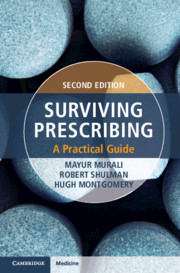Book contents
- Surviving Prescribing
- Reviews
- Surviving Prescribing
- Copyright page
- Contents
- Contributors
- Preface to the Second Edition
- Abbreviations
- Part 1 Introduction
- Part 2 Prescribing for Patient Groups
- Part 3 Emergency Prescribing
- Chapter 9 Diabetic Ketoacidosis
- Chapter 10 Hyperosmolar Hyperglycaemic State
- Chapter 11 Hypoglycaemia
- Chapter 12 Paracetamol Overdose
- Chapter 13 Emergency Prescribing in Cardiology
- Chapter 14 Emergency Prescribing in Neurosurgery
- Chapter 15 Respiratory Emergencies
- Chapter 16 Pulmonary Embolism
- Chapter 17 Electrolyte and Metabolic Emergencies
- Part 4 Gastrointestinal
- Part 5 Central Nervous System
- Part 6 Haematology
- Part 7 Surgery
- Part 8 Diabetes
- Part 9 Calculations
- Part 10 Interactions, Hypersensitivity and Contraindications
- Part 11 Infections and Other Important Topics
- Index
Chapter 14 - Emergency Prescribing in Neurosurgery
from Part 3 - Emergency Prescribing
Published online by Cambridge University Press: 08 June 2020
- Surviving Prescribing
- Reviews
- Surviving Prescribing
- Copyright page
- Contents
- Contributors
- Preface to the Second Edition
- Abbreviations
- Part 1 Introduction
- Part 2 Prescribing for Patient Groups
- Part 3 Emergency Prescribing
- Chapter 9 Diabetic Ketoacidosis
- Chapter 10 Hyperosmolar Hyperglycaemic State
- Chapter 11 Hypoglycaemia
- Chapter 12 Paracetamol Overdose
- Chapter 13 Emergency Prescribing in Cardiology
- Chapter 14 Emergency Prescribing in Neurosurgery
- Chapter 15 Respiratory Emergencies
- Chapter 16 Pulmonary Embolism
- Chapter 17 Electrolyte and Metabolic Emergencies
- Part 4 Gastrointestinal
- Part 5 Central Nervous System
- Part 6 Haematology
- Part 7 Surgery
- Part 8 Diabetes
- Part 9 Calculations
- Part 10 Interactions, Hypersensitivity and Contraindications
- Part 11 Infections and Other Important Topics
- Index
Summary
While the neurosurgical patient is not normally one junior prescribers should be caring for in a nonspecialist area, they may encounter them in the acute setting while a referral is being made. Readers are provided with key information on the management of subarachnoid haemorrhage, including how to manage blood pressure, prevent vasospasm and rebleeding. Adjuncts to reduce the chances of secondary brain injury, including steroids, mannitol and anticonvulsants, are also discussed, while the importance of good quality analgesia is also emphasised.
Keywords
- Type
- Chapter
- Information
- Surviving PrescribingA Practical Guide, pp. 57 - 60Publisher: Cambridge University PressPrint publication year: 2020

